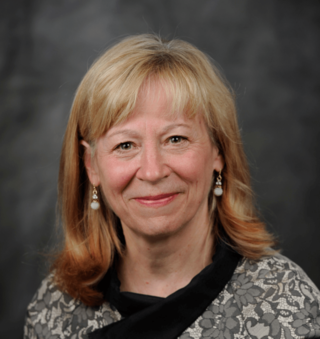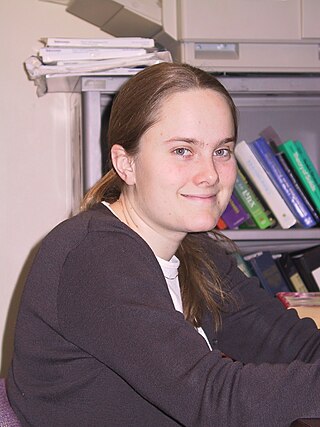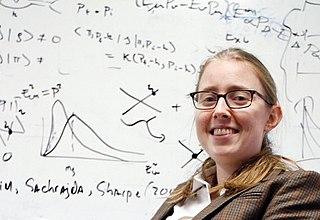Related Research Articles

William Daniel Phillips is an American physicist. He shared the Nobel Prize in Physics, in 1997, with Steven Chu and Claude Cohen-Tannoudji.
Markus Greiner is a German physicist and Professor of Physics at Harvard University.
Charles Tahan is a U.S. physicist specializing in condensed matter physics and quantum information science and technology. He currently serves as the Assistant Director for Quantum Information Science (QIS) and the Director of the National Quantum Coordination Office (NQCO) within the White House Office of Science and Technology Policy. Tahan is also Chief Scientist of the National Security Agency's Laboratory for Physical Sciences.
Richard C. Powell is an American professor emeritus of physics and vice president emeritus of the University of Arizona (UA), whose career focused on research in materials science and laser optics. He served as president of the Optical Society of America in 2000.

Ana Maria Rey is a Colombian theoretical physicist, professor at University of Colorado at Boulder, a JILA fellow, a fellow at National Institute of Standards and Technology and a fellow of the American Physical Society. Rey was the first Hispanic woman to win the Blavatnik Awards for Young Scientists in 2019. In 2023, she was elected to the National Academy of Sciences. She is currently the chair of DAMOP, the American Physical Society's division in Atomic, Molecular and Optical Physics (AMO).

Geraldine Lee Richmond is an American chemist and physical chemist who is serving as the Under Secretary of Energy for Science in the US Department of Energy. Richmond was confirmed to her DOE role by the United States Senate on November 5, 2021. Richmond is the Presidential Chair in Science and professor of chemistry at the University of Oregon (UO). She conducts fundamental research to understand the chemistry and physics of complex surfaces and interfaces. These understandings are most relevant to energy production, atmospheric chemistry and remediation of the environment. Throughout her career she has worked to increase the number and success of women scientists in the U.S. and in many developing countries in Africa, Asia and South America. Richmond has served as president of the American Association for the Advancement of Science, and she received the 2013 National Medal of Science.

Jun Ye is a Chinese-American physicist at JILA, National Institute of Standards and Technology, and the University of Colorado Boulder, working primarily in the field of atomic, molecular, and optical physics.

Peter James Reynolds is a theoretical physicist serving as a senior research scientist (ST) at the Army Research Office (ARO). He was formerly the ARO Physics Division chief and a program manager for atomic and molecular physics. Prior to joining ARO in 2003 he was at the Office of Naval Research, serving as a program officer, starting in 1988.

Albert Stolow is a Canadian physicist. He is the Canada Research Chair in Molecular Photonics, full professor of chemistry & biomolecular sciences and of physics, and a member of the Ottawa Institute for Systems Biology at the University of Ottawa. He is the founder and an ongoing member of the Molecular Photonics Group at the National Research Council of Canada. He is adjunct professor of Chemistry and of Physics at Queen's University in Kingston, and a Graduate Faculty Scholar in the department of physics, University of Central Florida and a Fellow of the Max-Planck-uOttawa Centre for Extreme and Quantum Photonics. In 2008, he was elected a Fellow in the American Physical Society, nominated by its Division of Chemical Physics in 2008, for contributions to ultrafast laser science as applied to molecular physics, including time-resolved studies of non-adiabatic dynamics in excited molecules, non-perturbative quantum control of molecular dynamics, and dynamics of polyatomic molecules in strong laser fields. In 2008, Stolow won the Keith Laidler Award of the Canadian Society for Chemistry, for a distinguished contribution to the field of physical chemistry, recognizing early career achievement. In 2009, he was elected a Fellow of the Optical Society of America for the application of ultrafast optical techniques to molecular dynamics and control, in particular, studies of molecules in strong laser fields and the development of new methods of optical quantum control. In 2013, he was awarded the Queen Elizabeth II Diamond Jubilee Medal (Canada). In 2017, Stolow was awarded the Earle K. Plyler Prize for Molecular Spectroscopy and Dynamics of the American Physical Society for the development of methods for probing and controlling ultrafast dynamics in polyatomic molecules, including time-resolved photoelectron spectroscopy and imaging, strong field molecular ionization, and dynamic Stark quantum control. In 2018, Stolow was awarded the John C. Polanyi Award of the Canadian Society for Chemistry “for excellence by a scientist carrying out research in Canada in physical, theoretical or computational chemistry or chemical physics”. In 2020, he became Chair of the Division of Chemical Physics of the American Physical Society. His group's research interests include ultrafast molecular dynamics and quantum control, time-resolved photoelectron spectroscopy and imaging, strong field & attosecond physics of polyatomic molecules, and coherent non-linear optical microscopy of live cells/tissues, materials and geological samples. In 2020, Stolow launched a major new high power ultrafast laser facility at the University of Ottawa producing high energy, phase-controlled few-cycle pulses of 2 micron wavelength at 10 kHz repetition rate. These are used for High Harmonic Generation to produce bright ultrafast Soft X-ray pulses for a new Ultrafast Xray Science Laboratory.
Klaus Mølmer is a Danish physicist who is currently a professor at the Niels Bohr Institute of the University of Copenhagen. From 2000 to 2022, he was a professor of physics at the University of Aarhus.
Ravinder Kumar Jain is an American engineer, physicist, and academic from the University of New Mexico. He was awarded the status of Fellow in the American Physical Society, after they were nominated by their Forum on Industrial and Applied Physics in 2008, for pioneering contributions in several areas of applied physics, including discovery of plasmon-mediated light-emission from tunnel junctions, seminal studies of nonlinear optics in semiconductors and optical fibers, and the invention of several important ultrashort pulse lasers and fiber lasers.

Mona Jarrahi is an Iranian Engineering professor at the University of California, Los Angeles. She investigates novel materials, terahertz/millimeter-wave electronics and optoelectronics, microwave photonics, imaging and spectroscopy systems.
Jelena Vučković is a Serbian-born American professor and a courtesy faculty member in the Department of Applied Physics at Stanford University. She served as Fortinet Founders Chair of the Department of Electrical Engineering at Stanford University from August 2021 through June 2023. Vučković leads the Nanoscale and Quantum Photonics (NQP) Lab, and is a faculty member of the Ginzton Lab, PULSE Institute, SIMES Institute, and Bio-X at Stanford. She was the inaugural director of the Q-FARM initiative. She is a Member of the National Academy of Sciences, and a Fellow of The Optical Society, the American Physical Society and the Institute of Electrical and Electronics Engineers.
Monika Schleier-Smith is an American experimental physicist studying many-body quantum physics by precisely assembling systems of ultracold atoms. These atomic, molecular, and optical physics (AMO) engineered systems have applications in quantum sensing, coherent control, and quantum computing. Schleier-Smith is an associate professor of physics at Stanford University, a Sloan Research Fellow, and a National Science Foundation CAREER Award recipient. Schleier-Smith also serves on the board of directors for the Hertz Foundation.

Michelle Povinelli is a Professor of Electrical Engineering and Physics and Astronomy at the University of Southern California (USC) and Fellow of the OSA and SPIE. Povinelli's research in nanophotonics focuses on the behavior of light inside complex materials.
Peter J. Delfyett Jr is an American engineer and Pegasus Professor and Trustee Chair Professor of Optics, ECE & Physics at the University of Central Florida College of Optics and Photonics.

Phiala Elisabeth Shanahan is an Australian theoretical physicist who lives and works in the United States. She is known for her work on the structure and interactions of hadrons and nuclei and her innovative use of machine learning techniques in lattice quantum field theory calculations.

Gretchen K. Campbell is an American atomic, molecular, and optical physicist associated with the National Institute of Standards and Technology. She works in the field of atomtronics and has received awards in recognition of her research contributions on Bose-Einstein condensates.
Mathias Michael Schubert is a German physicist, J. A. Woollam Distinguished Professor of Electrical and Computer Engineering at the University of Nebraska-Lincoln, and member of the Nebraska Center for Materials and Nanoscience. He is a specialist in spectroscopic ellipsometry and has contributed to the development of blue and white LED, fast processors and efficient biological and chemical sensors. He is also visiting professor at Linkoping University and Associate Editor of the journal Applied Physics Letters.

Randy Alan Bartels is an American investigator at the Morgridge Institute for Research and a professor of Biomedical Engineering at the University of Wisconsin–Madison. He has been awarded the Adolph Lomb Medal from the Optical Society of America, a National Science Foundation CAREER award, a Sloan Research Fellowship in physics, an Office of Naval Research Young Investigator Award, a Beckman Young Investigator Award, and a Presidential Early Career Award for Science and Engineering (PECASE). In 2020 and 2022, he received support from the Chan Zuckerberg Initiative to develop microscope technologies for imaging tissues and cells.
References
- ↑ "White House Announces 2005 Awards for Early Career Scientists and Engineers" (PDF). Office of Science and Technology Policy, Executive Office of the President. 2006-07-26. Retrieved 2018-11-12– via Center for Space Research, University of Texas at Austin.
- ↑ "APS Fellowship". www.aps.org. Retrieved 2017-04-20.
- ↑ "APS Fellow Archive". www.aps.org. Retrieved 2017-04-20.
- ↑ "APS Fellows 2008". www.aps.org. Retrieved 2017-04-20.